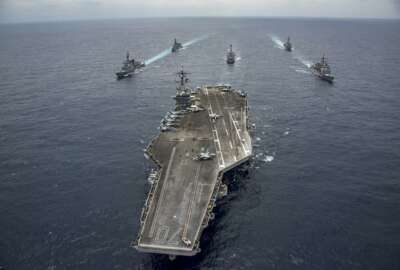The Navy is on its way to hiring thousands of new workers in shipyards and headquarters now that Congress has settled on a 2017 budget deal, but that doesn’t mean the service is out of the woods yet.
The Navy needs at least 2,000 more civilian employees to handle its ship maintenance backlog and the 2017 omnibus bill is a good start to hiring those workers, said Vice Adm. Thomas Moore, chief of Naval Sea Systems Command (NAVSEA) in an exclusive interview with Federal News Radio.
But 2017 funding, which gives NAVSEA about $1.7 billion, will only solve part of the issue, Moore said.
“That will be the first downpayment on our ability to start hiring people in 2017 that will eventually get us to where we need to be,” Moore said.
He added that the Navy will request additional money for 2018 to get ship depots to the right employment levels.
“The number one mission priority right now for NAVSEA is the on-time delivery of ships and submarines,” Moore said last month. “Today, we only deliver about 40 percent of our ships and submarines out of maintenance availabilities on time and that’s causing great stress for the fleet.”
That maintenance issue is with the Navy’s current fleet of 275 ships. Moore said the extra 2,000 workers would get rid of the maintenance backlog plaguing the shipyards. That would bring NAVSEA’s workforce to just over 36,000.
The Navy hired 16,500 workers over the past five years, but it is still getting its ships out of maintenance late. Part of the reason is because it takes time to train the new hires.
There is a two year time lag between when the Navy begins hiring shipyard workers and when they are actually in the depots. Meaning if the Navy gets the funds it wants, NAVSEA should reach the 36,000 employee marker by the end of fiscal 2019 or early 2020.
Moore would not go into details as to how much NAVSEA would ask for in the 2018 budget, but said the budget would be submitted shortly.
One area NAVSEA wants to grow is in its engineering force.
“We slashed the engineering force at a greater rate than we were ships [in the 1990s]. At the same time we were cutting ships, we were also building and designing new ships,” Moore said. During that design time DoD pushed more of the engineering to industry. Moore said the government has learned it wants a bigger role in that sector and more say in what it wants in a ship.
“In some cases we’ve learned the lesson the hard way on some ships. … The [Littoral Combat Ship] has had some challenges and we will work our way through those, but it’s probably a reflection that we didn’t have the size of the engineering force that we needed,” Moore said.
Along with engineers, Moore may need even more funding and a bigger workforce if the President and Congress decide to increase the naval fleet.
Right now it is on track to increase to 308 ships. The 2017 budget agreement put $3 billion more in the shipbuilding and conversion account than what was requested by the Obama administration.
The $21.2 billion total in the account will buy 13 new ships. That coincides with the maintenance backlog the Navy is trying to work off on its ships.
But, the Navy’s most recent force structure assessment issued in December calls for a fleet of 355 ships, on par with what President Donald Trump has proposed.
The Congressional Budget Office released a detailed assessment of what a fleet of that size would actually cost. The Navy would need to spend $26.6 billion per year for the next 30 years, 60 percent more than its average annual shipbuilding budget over the last three decades. The personnel, fuel and supply costs involved in maintaining a fleet of that size would also be 67 percent higher than they are now, according to CBO.
That would mean much bigger numbers for NAVSEA’s personnel.
In the meantime the command is focusing on readiness and repairing the ships it already has.
“Deferred maintenance is insidious, it takes a toll on the long-term readiness of the fleet,” Vice Chief of Naval Operations Adm. William Moran said in January. “When the transition team came around to all of us in the building and asked us what we could do with more money right now, the answer was not to buy more ships. The answer was to make sure the 274 that we had were maintained and modernized to make 275 ships worth of combat power, then we will start buying more ships.”
Moore said surface ship maintenance is a big priority.
“We kind of took a holiday from doing surface ship maintenance for about a five to six year period thinking we could get away with doing less maintenance and we kind of dug ourselves a hole and we woke up one morning in the 2007, 2008 timeframe and we had a bunch of surface ships failing,” Moore said.
Copyright
© 2024 Federal News Network. All rights reserved. This website is not intended for users located within the European Economic Area.

